Tom Baker interviews “Airbender” cast
Tom Baker (Chiba-ken, 1989-91) is a staff writer for The Daily Yomiuri. As another example of JET ROI, he is one of at least four former JETS to have been on the newspaper’s staff in recent years. He usually writes for DYWeekend, the arts and leisure section. You can follow Tom’s blog at tokyotombaker.wordpress.com.
Recently he interviewed two members of the cast of “The Last Airbender” movie during their promotional visit to Tokyo, asking them for their views on the “racebending” controversy surrounding their film. He also covered an insect show now running at a Tokyo museum, reviewed the manga “Otomen,” and weighed in on a couple of other movies now playing in Japan. Here are some excerpts:
“Last Airbender”
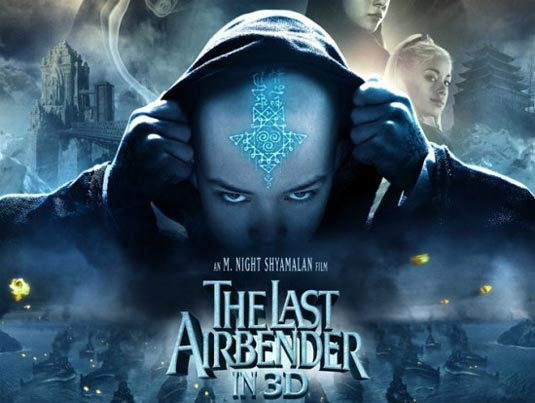 In the United States, some fans of the anime-style cartoon on which the movie is based have protested against the casting of Jackson Rathbone and Nicola Peltz, who are white, in roles the fans saw as Asian.
In the United States, some fans of the anime-style cartoon on which the movie is based have protested against the casting of Jackson Rathbone and Nicola Peltz, who are white, in roles the fans saw as Asian.
Asked to comment on that, Rathbone said: “I originally was a finalist for Prince Zuko [a Fire Nation role that went to Slumdog Millionaire star Dev Patel]. Almost a year later, I was brought back in for the character of Sokka…I think what they were really looking for was the qualities that people represent, not so much focusing on race…All these characters [in the cartoon] have so many different features, you can’t really say that they are one race…It’s a shame that people really focus on the race thing and they don’t understand that it’s a story for everyone.”
“And there are over 120 different types of people in the film,” Peltz added.
“In terms of a big-budget film, it’s the most ethnically diverse cast there’s ever been,” Rathbone agreed.
Read the rest of the interview here.
“Insects festival”
Open your window on a hot summer day and you may hear a sound that caught the ear of haiku poet Matsuo Basho in the 17th century: the voices of cicadas, seeping into the rocks. Of course, Japan today is a lot more urbanized than it was in Basho’s time, and cicadas are more likely to sing against a background of asphalt and cement. Yet year after year, the buzzing bugs never fail to show up, even in the heart of Tokyo.
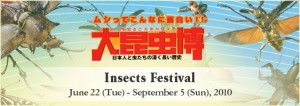 Visitors to Insects Festival, an exhibition now running at the Edo-Tokyo Museum in Ryogoku, Tokyo, are reminded of such persistence right away with a display of six-legged critters that live in three different Tokyo zones: mountains, fields and downtown areas.
Visitors to Insects Festival, an exhibition now running at the Edo-Tokyo Museum in Ryogoku, Tokyo, are reminded of such persistence right away with a display of six-legged critters that live in three different Tokyo zones: mountains, fields and downtown areas.
While city-dwellers often resent sharing space with the likes of cockroaches and ants, the emphasis of this show is on seasonal outdoor insects whose diverse shapes, bright colors and occasional songs actually enhance city life…
Read the rest of the article here, or visit the exhibition’s site here.
“Otomen”
 Anyone writing a graduate thesis on the presentation of gender in Japanese pop culture will find abundant material in the manga series Otomen. Readers looking for laughs will also find what they seek in Otomen, but rather less abundantly.
Anyone writing a graduate thesis on the presentation of gender in Japanese pop culture will find abundant material in the manga series Otomen. Readers looking for laughs will also find what they seek in Otomen, but rather less abundantly.
The main characters are a trio of high school students, with the focus on Asuka (a boy who has a name more common for girls), who is in love with Ryo (a girl who has a name more common for boys). Their would-be romance is complicated by the constant presence of their friend Juta, who tries to play cupid, but is more often a third wheel.
Asuka is the captain of the school kendo team, and is admired by everyone as a “real man.” But he is secretly an “otomen,” a boy who is into girly things, such as cute stuffed animals and delicate pastries. He is at least as skilled at cooking and sewing as he is at sports, but he keeps that side of himself hidden. Ryo is Asuka’s mirror image in that she has been raised by her socially inept father to follow in his footsteps as a martial arts champion, but she strives to put up a feminine front at school. Juta has a secret, too, as he is actually a best-selling manga artist who is using the couple as a model for his stories…
Also playing…
You can read Tom’s review of “Inception” here, and his review of “Zombieland” here.
WIT Life #110: Japan Cuts comes to a close
WITLife is a periodic series written by professional Writer/Interpreter/Translator Stacy Smith (Kumamoto-ken CIR, 2000-03). She starts her day by watching Fujisankei’s newscast in Japanese, and here she shares some of the interesting tidbits and trends together with her own observations.
Last Friday wrapped up Japan Cuts, the two-week, 25-film festival at Japan Society. Thanks to JS’s wonderful volunteering system I was able to see nine of the films at the festival itself, and another two in the comfort of my home. The final night wrapped up the event with the two movies About Her Brother and Sweet Little Lies. I was really looking forward to the latter, but I found the pacing slow and the movie’s story less stimulating than I thought it would be.
About Her Brother is one of those ubiquitous sentimental Japanese movies, but it wasn’t too heavy on the sappiness. Tsurube Shofukutei plays Read More
WIT Life #109: Parade
WITLife is a periodic series written by professional Writer/Interpreter/Translator Stacy Smith (Kumamoto-ken CIR, 2000-03). She starts her day by watching Fujisankei’s newscast in Japanese, and here she shares some of the interesting tidbits and trends together with her own observations.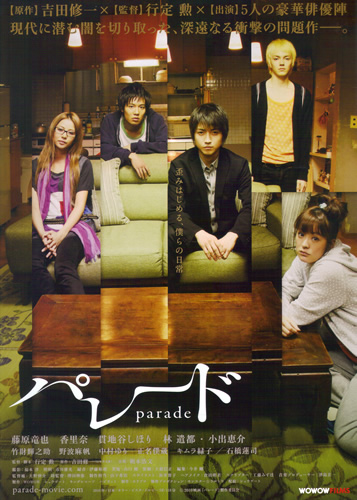
At Japan Society on Friday night I saw what has been my favorite movie of the Japan Cuts festival so far, Parade. A special treat was the attendance of the director, Isao Yukisada, to introduce the movie and take questions after. He presented the movie as a “slice of the dark side of Tokyo,” and expressed his nervousness and excitement at having his work screened here in New York for the first time. The movie explores the relationships between four young people sharing an apartment in Tokyo, as they deal with their respective troubles as well as the danger of an assailant who has been attacking women in the area. The title refers to Read More
WIT Life #108: On the Road
WITLife is a periodic series written by professional Writer/Interpreter/Translator Stacy Smith (Kumamoto-ken CIR, 2000-03). She starts her day by watching Fujisankei’s newscast in Japanese, and here she shares some of the interesting tidbits and trends together with her own observations.
Both films screened last night at Japan Society’s Japan Cuts festival were road movies. The first, Accidental Kidnapper, is reminiscent of Clint Eastwood’s A Perfect World, but I found the second one, One Million Yen Girl, to be more distinctly Japanese. Both feature well-known leads who are easy on the eyes (Katsunori Takahashi and Aoi Yu, respectively) and are backed by strong supporting casts, including Takashi Sasano who makes an appearance in both as an advocate for the main character.
In Accidental Kidnapper he plays a convict who advises Takahashi how to carry out his kidnapping, and in the latter he is a coffee shop proprietor in a small mountain village. In my previous double header, the actor Eita also appeared in both movies; he shows great versatility as one of the main characters in The Foreign Duck, The Native Duck and God in a Coin Locker and has a bit part in Hanging Garden. Both he and Sasano are also in Read More
WIT Life #107: Japan Cuts continued
WITLife is a periodic series written by professional Writer/Interpreter/Translator Stacy Smith (Kumamoto-ken CIR, 2000-03). She starts her day by watching Fujisankei’s newscast in Japanese, and here she shares some of the interesting tidbits and trends together with her own observations.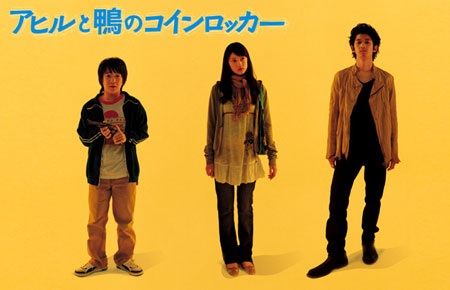
At the Japan Cuts film festival last night, I was able to attend both movies which were screened. The first was The Foreign Duck, The Native Duck and God in a Coin Locker and the one that followed was Hanging Garden. As a special treat, the director of the latter, Toshiaki Toyoda (who also directed Blood of Rebirth which was screened twice at the festival last week) was on hand to offer an introduction to his film and a Q&A session after. The director of the former, Yoshihiro Nakamura, also did Golden Slumber so it was interesting to be able to compare the two.
Director Nakamura clearly places great importance on music in his movies, to the point where is almost a secondary character. This is true in Golden Slumber which focuses on the title’s Beatles song, and in Foreign Duck it is Bob Dylan’s Blowin’ in the Wind. In both cases, the songs and their lyrics are Read More
WITLife is a periodic series written by professional Writer/Interpreter/Translator Stacy Smith (Kumamoto-ken CIR, 2000-03). She starts her day by watching Fujisankei’s newscast in Japanese, and here she shares some of the interesting tidbits and trends together with her own observations.
Last week was the start of the Japan Cuts film festival at Japan Society, where this year 24 films will be featured. This is the largest lineup ever and includes a wide variety of films. The Japan Society allows those who offer to volunteer at the festival the chance to stay and view the movie for free! I have decided to take advantage of this opportunity, and plan to help out during a couple of days of the festival. Stay tuned for reviews of the many movies I will have the chance to sample!
However, my first time at the festival was as a customer last Friday for the screening of the conspiracy theory comedy Golden Slumber. The plot of Read More
Japan Society kicks off annual JAPAN CUTS film fest
 By JQ Magazine’s Justin Tedaldi (CIR Kobe-shi, 2001-02) for Examiner.com. Visit his NY Japanese Culture page here to subscribe for free alerts on newly published stories.
By JQ Magazine’s Justin Tedaldi (CIR Kobe-shi, 2001-02) for Examiner.com. Visit his NY Japanese Culture page here to subscribe for free alerts on newly published stories.
July is here, and that means hot dogs, fireworks, and a horde of Japanese films served up by New York’s Japan Society for their annual JAPAN CUTS contemporary Japanese cinema festival. Launched at the tail end of the New York Asian Film Festival, Japan Society and NYAFF have teamed to co-present a whopping 24 films from July 1-16.
“JAPAN CUTS presents the roughest, sharpest, and smoothest of today’s cutting-edge Japanese film scene,” notes Japan Society’s chief film curator Samuel Jamier. “This year the lineup includes psycho dramas, thrillers, period pieces, bizarre comedies, refined melodramas, artistically adventurous indies, j-horror, and even anime. But when the lineup came together, I realized a number of these great films were made by female directors or featured a large number of prominent women’s roles and powerful performances by women–a reflection of industry trends in the last ten years, and the impact women have been making in Japan’s film industry. Overall, I like to think this year’s festival is exemplary of where Japanese cinema is today.”
For this week’s list, see the full article here.
Tom Baker reviews “Crazy Heart” and “Brothers”
Tom Baker (Chiba-ken, 1989-91) is a staff writer for The Daily Yomiuri. He usually writes for DYWeekend, the paper’s arts and leisure section. You can follow Tom’s blog at tokyotombaker.wordpress.com.
Recently he reviewed movies, “Crazy Heart” and “Brothers.” He found poetry in both of them. Here are some excerpts:
“Crazy Heart”
Country music singer-songwriter Bad Blake (Jeff Bridges) smokes like a chimney, drinks like a fish, sweats like a pig, and urinates into a plastic jug while driving from town to town. As I watched him perform under hot lights at a variety of small and unglamorous venues in the movie Crazy Heart, I could almost smell him. He didn’t smell very nice.
…
On the bright side, Bad’s personal problems are grist for the mill. One of his most popular songs looks back on a dissipated life with the refrain, “Funny how fallin’ feels like flyin’/for a little while.”
Anyone who doubts that country music is the primary home of modern American poetry should meditate on that line. “Funny how fallin’ feels like flyin'” is alliterative and catchy, but also trenchant. And Bad has flown and fallen quite a way…
Read the rest of the review here.
“Brothers”
In William Shakespeare’s play about his life, King Richard II is forced to surrender his crown to his usurper cousin Henry IV. In doing so, Richard compares himself and Henry to two buckets in a well: “The emptier ever dancing in the air,/The other down, unseen and full of water:/That bucket down and full of tears am I,/Drinking my griefs while you mount up on high.”
The title characters in Brothers, although they dwell in an American suburb rather than an English castle, are not unlike the tragic royal cousins.
Sam (Tobey Maguire) is an upstanding husband, father and U.S. marine who is about to be separated from his family for a tour of duty in Afghanistan. On the eve of Sam’s departure, his surly brother Tommy (Jake Gyllenhaal), a ne’er-do-well with a drinking problem, rejoins the extended family after a stint in prison…
Read the rest of the review here.
WIT Life #103: The Cove
*********************************************************
WITLife is a periodic series written by professional Writer/Interpreter/Translator Stacy Smith (Kumamoto-ken CIR, 2000-03). She starts her day by watching Fujisankei’s newscast in Japanese, and here she shares some of the interesting tidbits and trends together with her own observations.![]()
An article in today’s Times discusses the reaction of right wingers in Japan to The Cove, a documentary about dolphin hunting in a place called Taiji. This group, 右翼 or uyoku, are said to number about 10,000 throughout the country and have been responsible for various acts of violence such as torching the houses of politicians whose views they don’t agree with (i.e. regarding visits to Yasukuni Shrine). This time they are protesting outside theaters attempting to show this film, insisting that it will “poison Japan’s soul.” However, there is significant interest in this doc as evidenced by the turnout of over 700 people for a one-time screening in Tokyo last week, where about 100 had to be turned away due to lack of space.
Quoted in the article is the documentary filmmaker and author Tatsuya Mori, who I Read More
WIT Life #100: ダーリンは外国人
**************************************************************
WITLife is a periodic series written by professional Writer/Interpreter/Translator Stacy Smith (Kumamoto-ken CIR, 2000-03). She starts her day by watching Fujisankei’s newscast in Japanese, and here she shares some of the interesting tidbits and trends together with her own observations.
Last night I went to see the US premiere of ダーリンは外国人 or My Darling is a Foreigner. This film is based on the manga series with the same title by Saori Oguri. I was introduced to this work by a Japanese friend shortly after it came out in 2002, and I devoured the volumes that were available at the time. It depicted the day to day life of this international couple and the bumps that they encountered along the road of their relationship. They eventually went on to have a child together, and since the first book went on sale this popular series has sold 3 million copies.
Tony is the name of Saori’s husband and he hails from the United States. He is Read More
Interview with ‘Beetle Queen Conquers Tokyo’ Director Jessica Oreck
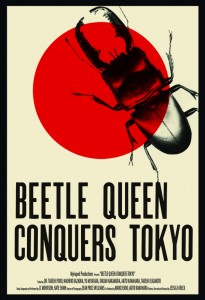 The film Beetle Queen Conquers Tokyo explores the history and mystery of the development of Japan’s love affair with bugs, underscoring ancient philosophies that will shift Westerners’ perspectives. JQ Magazine’s Justin Tedaldi (CIR Kobe-shi, 2001-02) talked with producer/writer/director Jessica Oreck on the eve of the film’s New York premiere for Examiner.com. Visit his NY Japanese Culture page here to subscribe for free alerts on newly published stories.
The film Beetle Queen Conquers Tokyo explores the history and mystery of the development of Japan’s love affair with bugs, underscoring ancient philosophies that will shift Westerners’ perspectives. JQ Magazine’s Justin Tedaldi (CIR Kobe-shi, 2001-02) talked with producer/writer/director Jessica Oreck on the eve of the film’s New York premiere for Examiner.com. Visit his NY Japanese Culture page here to subscribe for free alerts on newly published stories.
Would you describe this film as a documentary, or something else?
I try not to label films too methodically. Some of my favorite “narrative” films are not “documentary” but certainly seem more honest than films based on facts. So I guess I’ll just keep it simple and call it a movie.
Have you always had an interest in insects and Japan? What made you want to go there to capture these images personally?
I have loved insects since I was a little girl, so when I stumbled onto the Japanese enthusiasm for the same ostracized order, it felt like it was meant to be. I studied filmmaking, biology and ecology in university; I knew I wanted to make films about ethnobiology, so this was the perfect film with which to start.
The Japanese concept of mono no aware (which describes the awareness in the transience of things) is invoked early on in the film. Was this the original thesis before filming, or did this thread to traditional concepts develop later in the process?
I did extensive research before traveling to Japan, and I laid out a 17-page essay that included pieces of Japanese history and philosophy I hoped to incorporate into the film. Mono no aware was just one of the many ideas that were intricately tied together within the architecture of the film as I initially envisioned it. I knew it would be part of the film’s foundation, but as the editing process progressed and I continued to refine the essay and skim off outer details, the concept of mono no aware became more and more pronounced. In this way, editing the footage and writing and editing the narration was a very organic process.
Were there any older Japanese-made films tackling this subject that you watched for reference?
As far as I know there are no other films that address this subject in particular. There are some fantastic Japanese films that have a lot of bugs in them—one of my favorites being Woman in the Dunes. But I think the Japanese film that I watched most often while making Beetle Queen was Kon Ichikawa’s Tokyo Olympiad. That movie is infinitely perfect to me.
Several scenes in the film depict Japanese children’s love of insects. Were the ones you filmed typical of that kind of interest, or were they more passionate than most about this? How would you define Japanese kids’ relationship with the insect world compared to American kids’?
A Japanese child’s relation to insects isn’t that different from an American’s child connection—if you catch them young enough. Most young children don’t have an innate fear of bugs (from my experience watching thousands of them pass through the butterfly vivarium at the American Museum of Natural History). It isn’t until they see dad flinch or mom scream that they learn disgust or fear. What’s different with a Japanese child is that they are encouraged to explore the insect world. They keep them as pets, their dads take them on insect collecting trips, and they travel halfway across the country to watch the fireflies emerge at dusk. I am generalizing, of course, but the phenomenon is, by and large, quite widespread.
In comparison, I believe that a Westerner’s view of the natural world is, in part, dictated by the cultural heritage of what I call the Judeo-Christian syndrome, through which we see the world as a linear chain of progress that culminates in the human form and bestows the power of control to the animals with the least sense of balance. However, I think an individual’s understanding of the natural world is still mostly directly absorbed through the behavior of the people they admire, and that that is why this connection to insects continues to thrive in Japanese culture.
The author and anatomist Dr. Takeshi Yoro is the only person interviewed on-camera for this film. How did you discover him, and were there any other experts or authorities whom you considered speaking with?
Dr. Yoro is a famous guy in Japan, so everywhere we went people asked if we had plans to interview him. Eventually we just decided to call him and, miraculously, he said he would be happy to be interviewed. It was never my intent to have talking heads, but so many of the things that Dr. Yoro said felt like pure poetry—he ended up being the key to some of my favorite parts in the movie.
Generally, what kind of support did you receive from the Japanese people you worked with and filmed? What was their reaction to an American filmmaker exploring what seems to be a uniquely Japanese interest?
Everyone was happy to have us, though they were often confused about why we were making this film. We got a lot of, “What? They don’t sell beetles in America?”
What should more Americans be aware of with respect to the insect world?
Well, I hate to limit the film’s impact to the insect world. To me, the film is about much more than bugs. I have had the opportunity to observe a myriad of reactions. Plenty of people have been surprised by the loss of their fear, or by newfound knowledge, or a novel appreciation for beauty in unanticipated facets of their life. But my favorite story is of a World War II veteran who approached me after a screening of Beetle Queen. He said something to the effect of, “For fifty years I have thought of the Japanese as my enemy. And in the past hour and a half, you have changed that.”
Are there any plans to screen the film in Japan?
Not yet! But we are always looking for opportunities!
Beetle Queen Conquers Tokyo runs from May 12-18 at New York’s Film Forum, with Jessica appearing at screenings on May 12, 14 and 16. Visit www.beetlequeen.com for more info, and sign up for the mailing list at info@beetlequeen.com.

